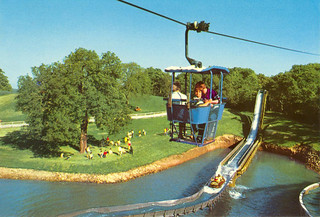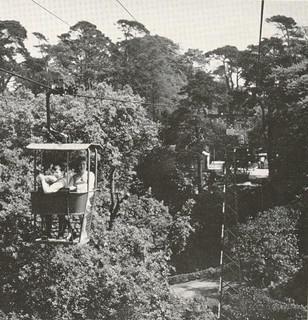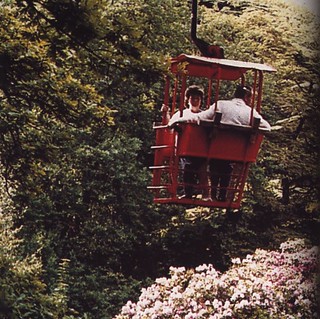Cable Cars
 It's almost impossible to imagine Alton Towers without the Skyride but long before the modern, multicoloured gondolas glided high above the Gardens, a very different fleet of multicoloured Cable Cars served the same role within the park for over 20 years.
It's almost impossible to imagine Alton Towers without the Skyride but long before the modern, multicoloured gondolas glided high above the Gardens, a very different fleet of multicoloured Cable Cars served the same role within the park for over 20 years.
The Cable Cars gave guests previously unprecedented aerial views of the park and were one of the earliest static rides to be introduced to Alton Towers, transporting guests from the Courtyard to the Chinese Temple (now known as the Gothic Prospect Tower) in style. This opened up the spectacular garden views of The Towers to a much larger audience by removing the need to navigate through the winding paths of the Gardens.
Open-sided Cable Cars were a very popular attraction during the 1960s, and were a familiar sight in amusement parks and seaside towns across the country. Most notably, Butlins made the attractions a common sight for holidaying Britons by introducing Chairlifts to six out of their nine seaside holiday camps, though similar attractions could also be found in traditional seaside parks such as Blackpool Pleasure Beach.
Alton Towers' model was unusual as it was one of the few examples to pass through densely wooded areas, giving a very different ride to the bright and breezy models to be found in many parks.
The Life & Times
 The Cable Cars offered guests a tree-top ride across the Ingestre Centre, following a similar route to that taken today by the first half of the Skyride between Mutiny Bay and Forbidden Valley.
The Cable Cars offered guests a tree-top ride across the Ingestre Centre, following a similar route to that taken today by the first half of the Skyride between Mutiny Bay and Forbidden Valley.
The ride was built by British Ropeway Engineering in 1963 and each open-air gondola could carry up to 4 guests. The nature of the attraction however, meant this pre-cursor of the modern Skyride could not safely pass over the 200ft valley of the Gardens, to what is today Cloud Cuckoo Land, making it more of a sightseeing attraction then a transportation device.
More subtly, the route across the Ingestre Centre was also different to that taken by the Skyride today. The Cable Cars took guests from a station located on the site now occupied by the Pirates Quest arcade, across the upper level of the garden to a station that could be found directly at the top of the stairs neighbouring the Gothic Prospect Tower. This meant that whilst the current Skyride passes by the side of the Flume, and over the Courtyard, in their later years the Cable Cars actually passed directly over the centre of the Log Flume, offering a much better view of the water ride.
What Happened Next...
 In many ways the Cable Cars were a victim of their own success, proving to be a consistently popular sightseeing attraction, whilst also opening the up the tantalising possibility of developing the land to the North of the Gardens. However to realise the potential of this side of the park, a much higher capacity ride was required for the job than 14 small Cable Cars could offer.
In many ways the Cable Cars were a victim of their own success, proving to be a consistently popular sightseeing attraction, whilst also opening the up the tantalising possibility of developing the land to the North of the Gardens. However to realise the potential of this side of the park, a much higher capacity ride was required for the job than 14 small Cable Cars could offer.
In its final days during the 1986 season, a new view would have been offered from the Cable Cars, with guests now able to watch the initial construction work for the new, high capacity Skyride system, which replaced the attraction during the 1987 season.
The new Skyride station was built alongside the recently completed Towers Street development and thus the Cable Cars' removal freed up more space behind the Courtyard, allowing for the construction of a new Aquarium and also the introduction of The Tea Cups (today known as Marauder's Mayhem).
But the story didn't end there... The legacy of Alton Towers' Cable Cars lives on to this day, as the ever-popular Skyride continues to take guests from Mutiny Bay through to the Chinese Temple, a few metres from where the original Cable Cars had glided gently through the trees.
The fate of the Cable Cars at Alton Towers was very much an omen for future of similar models across the country. Over the following years many seaside resorts and theme parks lost their familiar Cable Cars with Butlins gradually closing their fleet of Chairlifts and many other parks such as Blackpool Pleasure Beach and Drayton Manor also quietly removing these low throughput attractions (often amid Health and Safety concerns, due to the open nature of the cars).

